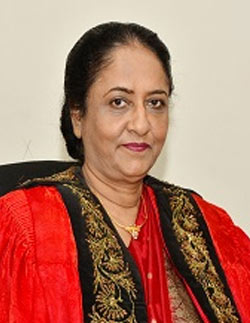|

|
|
Dear Members,
As I am writing these words, the country is facing a severe disaster situation due to inclement weather conditions and their impacts. The Disaster Management Centre is reporting of flood and landslide risk in 19 provinces; 12 deaths, 43 houses fully damaged and 3,172 houses partially damaged; 56,472 persons (14,500 families) housed in 246 refugee stations; NBRO has issued red alerts for potential risk of landslides in 23 DSD’s in Ratnapura, Kegalle, Nuwara Eliya, Kalutara and Galle Districts.
|
|
Although these are called ‘natural disasters’, as against ‘man-made disasters’ like warfare and accidents, we now understand that human activities do have a major hand in these disasters too. From climate change at the global level to changes in weather patterns at local level, these disasters result from how we interfere with nature by upsetting the natural material and energy balances. While actions like release of carbon dioxide and other greenhouse gas emissions and cutting down trees and vegetation that help trap the carbon without releasing it into the atmosphere result in retaining the heat that should have been emitted from the atmosphere, cause global warming and climate change, at the local level, deforestation and increasing built up areas interferes with the water cycle, result in changes in intensity and duration of rainfall, as well as impacts of the rainfall due to changes in the drainage patterns on land, such as flooding, erosion, landslides etc. We can see the consequences of this right now. That is why we cannot be complacent about these disasters as ‘natural disasters’ and be prepared to accept and react to them, any more.
We engineers are often blamed for working against nature, in order to get things done. Indiscriminate cutting down of trees for buildings, roads, power lines, pipelines, canals etc., blasting and removing rocks for construction, even blocking waterways and filling up large areas of land for reservoirs, although done with the intention of providing services to humans, have overall impacts that were ignored in the past. We need to be working with nature, not against it. We engineers can do this if we set our minds to it. It is our creativity that needs to be mobilized in the right way – which of course means that we need to understand the natural systems well, and we need to work in teams, respecting other disciplines as well as our own.
While engineers are at the forefront when it comes to managing the aftermath of these disasters, providing housing, water supply, reconstruction of roads, railways, pipelines and other infrastructure, I believe that we are the ones who are capable of preventing them too. We have to realize that what was thought to be the best technologies twenty or thirty years ago may not be the best any more, as new knowledge is added, more information is available and new experiences are gathered. While engineering principles may remain the same over many decades, even centuries, technologies change very fast, and more economical, more resource and energy efficient, more safe and more flexible ways of doing things keep emerging. Unless if we start questioning ourselves on the way we do things conventionally, we will never be able to harvest the advantages of the inbuilt skills that we possess as perhaps the most creative and intelligent section of our society. Do we need so much of concrete and steel for a structure? Where do these materials come from? If we can reduce the amount of concrete, what does that really mean to the earth? - taking just the coarse aggregate component - there will be less rock blasting, less fuel usage for transport, less air pollution, less noise, dust and smoke, less erosion etc. etc. Can the same strength, durability, cost effectiveness, safety and other attributes be gained with a different design, material or method of construction which is less impacting on nature? These are the challenges that we must be prepared to face, as the population increases, demand for facilities increases with the expectations of a more sophisticated population, and the natural resources keep diminishing due to irreversible uses. It is high time that we seriously think about doing things in a way that does not conflict with nature.
Thank you.
Eng. (Prof.) Mrs. Niranjanie Ratnayake
President, Institution of Engineers, Sri Lanka
2017/2018
|